Physical Address
304 North Cardinal St.
Dorchester Center, MA 02124
Protocol for posterior cruciate ligament reconstruction for procedures with high-strength two-strand graft (quadriceps tendon-bone, bone-patellar tendon-bone).
Progress patient on athletic and occupational goals, condition of the articular surfaces and menisci, return muscle function, postoperative healing, remodeling.
Supervised rehabilitation program supplemented with home exercises performed daily.
Monitor joint swelling, pain, gait pattern, knee motion, patellar mobility, muscle strength, and flexibility continually after surgery.
Avoid any exercises or activities that place high posterior shear forces on the tibia, such as walking down inclines, squatting, or hamstring flexion curl machines for the first 6 postoperative months.
Avoid strenuous activities for 9 to 12 months and activities that produce pain, swelling, or a feeling of instability.
Posterolateral reconstruction: too early resumption of weight bearing is deleterious to healing graft.
A paucity of information exists in the literature regarding rehabilitation for injuries to the posterior cruciate ligament (PCL) and posterolateral structures. The posterolateral structures comprise the fibular collateral ligament and popliteus muscle-tendon-ligament unit, including the popliteofibular ligament and posterolateral capsule. A recent systematic review failed to find high-level evidence studies of rehabilitation protocols for either conservative or operative treatment of these injuries. The rehabilitation protocols described in this chapter consist of a careful incorporation of exercise concepts supported by biomechanic and clinical data and over 3 decades of patient experience. The goal is to progress a patient at a rate that takes into account the condition of the articular surfaces and menisci, return of muscle function and lower limb control, postoperative graft healing and remodeling, and athletic and occupational goals. Modifications to the postoperative exercise program may be required if noteworthy articular cartilage deterioration is found during surgery.
The protocol for PCL reconstruction was developed for high-strength quadriceps tendon-patellar bone (QT-PB) autografts or Achilles tendon-bone allografts with interference screw fixation of the bone and soft tissue portions (and additional suture fixation of the tendon portion over a suture post; see Chapter 16 ). The protocol for posterolateral reconstruction may be used after the various operative options described in detail in Chapter 17 , including anatomic reconstructions, femoral-fibular reconstructions, and proximal advancement techniques of the posterolateral structures.
The supervised rehabilitation programs are always supplemented with home exercises performed daily. The therapist must routinely examine the patient in the clinic to implement and progress the appropriate protocol. Therapeutic procedures and modalities are used as required for successful rehabilitation. For the majority of patients, a range of 11 to 21 postoperative physical therapy visits is expected to produce a desirable result. A few more visits may be required between the sixth and twelfth postoperative months for certain patients who desire to return to strenuous activities for advanced training.
For all patients, joint swelling, pain, gait pattern, knee motion, patellar mobility, muscle strength, and flexibility are continually monitored postoperatively.
Patients are warned to avoid any exercises or activities that place high posterior shear forces on the tibia such as walking down inclines or squatting for the first 6 postoperative months. In addition, patients are cautioned that an early return to strenuous activities postoperatively carries a risk of a repeat injury or the potential of compounding the original injury. These risks cannot always be scientifically predicted, and patients are cautioned to avoid strenuous activities for 9 to 12 postoperative months and to avoid activities that produce pain, swelling, or a feeling of instability. These patients are monitored after surgery with posterior drawer testing and stress radiography if an increase in posterior tibial displacement is detected.
Patients with posterolateral reconstruction are warned specifically at the fourth to eighth postoperative weeks when weight bearing and weaning of crutches occur to avoid hyperextension, varus, or internal tibial rotation positions that could place high tensile forces on the posterolateral structures. It is important that the patient demonstrates good lower extremity control with suitable muscle strength to maintain tibiofemoral compression and avoid a lift-off of the lateral tibiofemoral joint that would disrupt the posterolateral reconstruction.
Isokinetic flexion exercise exerts moderate posterior shear forces; use cautiously after PCL reconstruction.
Posterior shear forces significantly increased during standing by anterior flexion of the trunk.
Static squat: significant increase in posterior tibial translation occurs at high knee flexion angles.
Large posterior shear forces exist during jogging, ascending and descending stairs.
Open kinetic chain flexion exercise produces posterior shear forces beyond 30 degrees of knee flexion.
Closed kinetic chain leg press produces significantly less posterior shear forces than OKC flexion. Cocontraction of quadriceps and hamstrings occurs during CKC, greatest at 30 degrees and 60 degrees of knee flexion.
Posterior shear forces during CKC squat exercise are relatively low from 0 to 45 degrees of knee flexion. Cocontraction of quadriceps and hamstrings occurs from 0 to 30 degrees of flexion.
OKC knee extension produces posterior shear forces from 60 to 100 degrees of knee flexion, but these forces are lower than those measured during CKC leg press and squat exercises.
Leg press induces minimal hamstring muscle activity.
In situ forces in the PCL significantly increase with knee flexion in response to an isolated hamstrings load, reaching a maximum at 90 degrees of flexion. A simulated cocontraction of the quadriceps and hamstrings reduces the in situ forces in the PCL.
Isokinetic extension exercise at knee flexion angles less than 70 degrees safe early postoperatively.
Isokinetic flexion and deep squats should be avoided early after PCL reconstruction.
Hamstrings load significantly increases PCL force from 15 to 120 degrees of knee flexion.
The application of tibial torque in either an anterior or posterior direction when the knee is flexed greater than 60 degrees increases PCL force. Isolated hamstrings activity (with tibial torque) further increases PCL force.
Many studies have demonstrated that posterior tibial subluxation occurs in PCL-deficient knees during activities of daily living in high knee flexion positions, but not usually at low flexion positions where smaller posterior shear forces are present. In activities such as sudden stopping, deceleration, or walking down a ramp, a posterior subluxation of the tibia is expected to occur.
Using knee models created from magnetic resonance imaging (MRI) and dual fluoroscopy, several recent investigations found significant differences in knee kinematics at higher knee flexion angles during a single-leg lunge between PCL-deficient and contralateral normal knees. For instance, Gill and colleagues reported PCL-deficient knees had significantly increased posterior tibial translation between 60 degrees and 120 degrees of flexion compared with normal knees (mean difference, 3.5 ± 1.1 mm, P < .05). Significant decreases in patellar rotation and tilt were also observed between PCL-deficient knees and normal knees between 75 degrees and 120 degrees of knee flexion.
Using lateral radiographs, Castle and colleagues measured posterior tibial subluxation during a static double-legged squat in patients with PCL-deficient knees. The results revealed a statistically significant mean increase of 5.9 mm in posterior tibial translation ( P < .05) of the injured knee compared with the contralateral knee at high knee flexion angles. At low flexion angles, the magnitude of increase in mean posterior tibial translation was only 2.1 mm. Tibiofemoral shear forces were small compared with tibiofemoral joint compression forces.
Two- and 3-dimensional biomechanic models have been used to predict forces generated during exercises and on standing at different knee flexion angles. Kaufman and coworkers used a 3-dimensional biomechanic model to predict dynamic patellofemoral and tibiofemoral forces generated during isokinetic exercises at 60 degrees/sec and 180 degrees/sec. During isokinetic extension, posterior shear forces were detected at knee flexion angles of 40 degrees and greater. The maximum posterior shear force occurred at 70 to 80 degrees of knee flexion and measured 0.5 ± 0.1 body weight at 60 degrees/sec and 0.6 ± 0.1 body weight at 180 degrees/sec. A posterior shear force occurred throughout the entire flexion exercise at all knee flexion angles, reaching a peak at 75 degrees of knee flexion of 1.7 ± 0.8 body weight (60 degrees/sec) to 1.4 ± 0.5 body weight (180 degrees/sec). The authors concluded that isokinetic exercise exerted moderate posterior shear forces and should be used cautiously after PCL rupture and reconstruction.
Ohkoshi and associates used a 2-dimensional model to calculate shear force exerted on the tibia during standing at various knee flexion angles in 21 healthy subjects. Posterior shear forces were found in the upright position of the trunk and at knee flexion angles of 15 to 90 degrees ( Fig. 18-1 ). At 30 degrees and 60 degrees, the posterior drawer force was significantly increased by anterior flexion of the trunk.
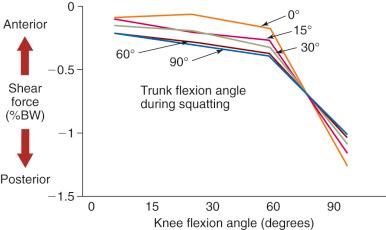
Berchuck and coworkers calculated large posterior shear forces during gait analysis for the activities of jogging, ascending stairs, and descending stairs ( Fig. 18-2 ) in five normal subjects. Lutz and associates evaluated tibiofemoral joint shear and compressive shear forces using a 2-dimensional biomechanic model and electromyographic (EMG) of hamstrings and quadriceps muscle activity during a closed kinetic chain (CKC) leg press exercise, an isometric open kinetic chain (OKC) extension exercise, and an OKC flexion exercise. Measurements of maximum muscle contractions were obtained at 30, 60, and 90 degrees of knee flexion. The OKC isometric flexion exercise produced posterior shear forces at all knee flexion angles ( Fig. 18-3 ), ranging from –939 ± 174 N at 30 degrees of knee flexion to a maximum of –1780 ± 699 N at 90 degrees of knee flexion. The CKC exercises produced significantly lower posterior shear forces at 60 degrees and 90 degrees of flexion (–538 N, P < .05). These findings were similar to those reported by Smidt during isometric knee extension and flexion exercises ( Fig. 18-4 ). Maximum hamstrings EMG activity was detected during the OKC exercise at 90 degrees of flexion (82% ± 15% of maximum contraction). The antagonistic muscle activity was minimal during this exercise at all knee flexion angles. In contrast, cocontraction of the quadriceps and hamstrings was observed during the CKC exercise, which was greatest at 30 degrees and 60 degrees of flexion. The authors concluded that CKC exercise produced significantly lower tibiofemoral shear forces compared with OKC exercise ( P < .05).
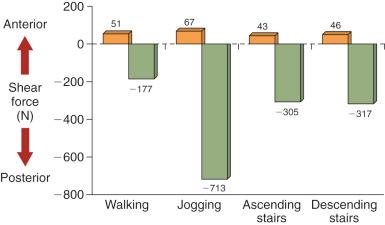
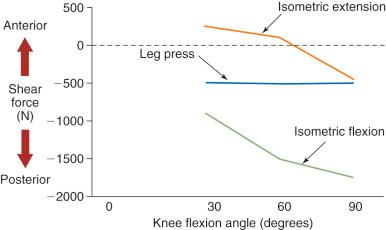
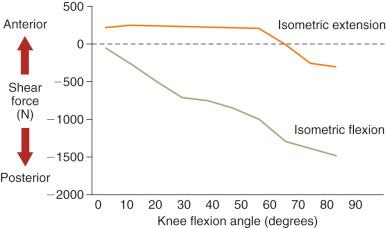
Wilk and colleagues evaluated tibiofemoral shear forces and EMG activity of the quadriceps, hamstrings, and gastrocnemius muscles during OKC extension and CKC leg press and squat exercises. Both CKC exercises produced posterior shear forces. However, during the squat, these forces were relatively low (245 to 565 N) from 0 to 45 degrees of knee flexion. A rapid increase in posterior shear forces was detected from 45 to 72 degrees of flexion. In addition, cocontraction of the quadriceps and hamstrings occurred from 0 to 30 degrees of flexion.
Wilk and colleagues also found that the knee extension exercise produced posterior shear forces from 60 to 100 degrees of knee flexion; however, these forces were lower than those measured during both CKC exercises. The leg press induced minimal hamstring muscle activity.
Hoher and coworkers reported that the in situ forces in the PCL significantly increased with knee flexion in response to an isolated hamstrings load, reaching a maximum at 90 degrees of flexion. These findings were in agreement with other authors who also reported increased strain in the PCL with knee flexion. The addition of a 200-N quadriceps load (simulating cocontraction of the quadriceps and hamstrings) reduced the in situ forces in the PCL.
Toutoungi and associates combined noninvasive experimental measurements with geometric modeling of the lower extremity to calculate ligament forces during isometric, isokinetic, and squat exercises. The data indicated that isokinetic extension at knee flexion angles less than 70 degrees should be safe in the early postoperative period following PCL reconstruction. However, isokinetic flexion and deep squats should be avoided. During isokinetic flexion, only the PCL is loaded and peak forces may reach over four times the patient's body weight at 90 degrees of knee flexion. During squatting, PCL forces may reach 3.5 times body weight at high knee flexion angles. Shallow squats with knee flexion angles kept below 50 degrees may be considered.
Markolf and colleagues studied the effects of muscle loads on cruciate force levels when the knee was subjected to external forces and moments. Load cells were installed into cadaveric knees to record forces in the ACL and PCL under five loading conditions. These force measurements were repeated with a 100-N load applied to the quadriceps tendon and with a combined 50-N load applied to both the biceps and semimembranosus-semitendinosus tendons.
With no applied tibial force, application of hamstrings load significantly increased mean PCL force from 15 to 120 degrees of knee flexion ( Fig. 18-5 ). With the application of a 100-N posterior tibial force, the addition of hamstrings load significantly increased mean PCL force between 30 degrees and 105 degrees of flexion ( Fig. 18-6 ). When a 5 N-m external tibial torque was applied, the addition of hamstrings load significantly increased mean PCL force beyond 75 degrees of knee flexion ( P < .05). Under a 5 N-m internal tibial torque, application of hamstrings load also significantly increased mean PCL force between 60 degrees and 100 degrees of flexion ( P < .05). The authors concluded that, in general, the hamstrings were more effective in producing changes in cruciate force levels. Application of tibial torque in either an anterior or posterior direction when the knee was flexed greater than 60 degrees increased PCL force, and isolated hamstrings activity (with tibial torque) further increased PCL force.
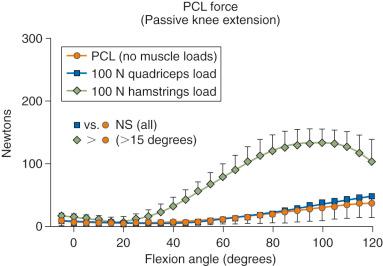
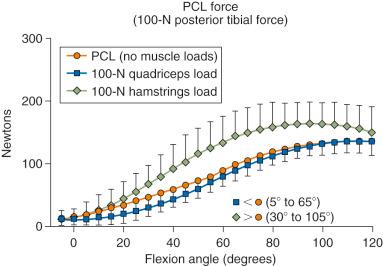
This program does not apply to PCL avulsions in which surgery may be indicated, and partial PCL tears with 5 mm or less of increased posterior tibial translation. The goal with complete PCL disruptions (8-10 mm of increased posterior tibial translation at 90 degrees of flexion) is to allow PCL healing and reduce abnormal posterior tibial translation. Importantly, this includes maintaining normal tibiofemoral contact at full knee extension or with knee flexion. An anterior drawer produced by the therapist during motion in the early phases of rehabilitation will allow for protection of healing PCL fibers. This protective program for acute PCL ruptures has been used by us for over 20 years. The rules to treat partial or acute isolated PCL tears are as follows:
Patient is within 14 days of the injury.
Protect for 6 weeks in full knee extension with a brace and posterior calf pad ( Fig. 18-7 ) or bivalved cylinder cast to maintain tibiofemoral reduction. Use quadriceps isometrics, electrical muscle stimulation (EMS), leg raises, and 25% weight bearing.
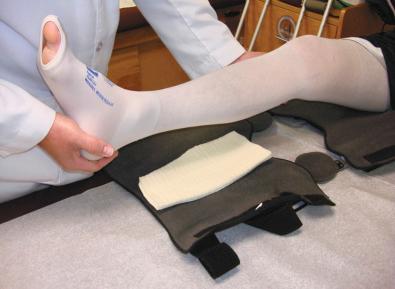
Obtain a lateral radiograph to verify no posterior tibial subluxation exists, which can occur in up to 50% of knees.
At 2 weeks, the therapist initiates 0 to 90 degrees of motion, maintaining anterior tibial translation load during knee motion exercises. The patient must sleep in the brace and is not allowed unsupervised knee motion. Only passive flexion with the therapist is permitted.
At 4 weeks, the patient is allowed to perform active quadriceps extension without the brace, use 50% weight bearing with crutch support, and continue brace protection.
At 5 to 6 weeks, the patient is weaned from the brace and crutch support and the rehabilitation protocol (described later) is begun. It should be noted that some centers use a Jack PCL Brace (Albrecht, Germany) to provide added protection against posterior tibial subluxation, which may be considered if insomnia issues are resolved.
At 6 months, a posterior stress radiograph determines the amount of posterior tibial translation compared with the opposite knee.
Patients are instructed in the rehabilitation program preoperatively. They present to physical therapy the first day after surgery on bilateral axillary crutches in a postoperative dressing with a long-leg brace locked in full extension with a posterior calf pad ( Table 18-1 ). The postoperative bandage and dressing are changed to allow the application of thigh-high compression stockings and a compression bandage. Early control of postoperative effusion is essential for pain management and early quadriceps reeducation. In addition to compression, cryotherapy is important in this time period.
| POSTOPERATIVE WEEKS | POSTOPERATIVE MONTHS | ||||||||
|---|---|---|---|---|---|---|---|---|---|
| 1-2 | 3-4 | 5-6 | 7-8 | 9-12 | 4 | 5 | 6 | 7-12 | |
| Hinged long-leg postoperative brace | X | X | X | ||||||
| Patellar knee sleeve | X | X | X | X | |||||
| Functional brace | X | X | |||||||
| Range of motion minimum goals (degrees): | |||||||||
| 0-90 | X | ||||||||
| 0-110 | X | ||||||||
| 0-120 | X | X | |||||||
| 0-135 | X | ||||||||
| Weight bearing: | |||||||||
| 25% body weight | X | ||||||||
| 50% body weight | X | ||||||||
| Full | X | ||||||||
| Patellar mobilization | X | X | X | X | |||||
| Modalities: | |||||||||
| EMS | X | X | X | X | X | ||||
| Pain/edema management (cryotherapy) | X | X | X | X | X | X | X | X | X |
| Stretching: hamstring, gastrocnemius-soleus, iliotibial band, quadriceps | X | X | X | X | X | X | X | X | X |
| Strengthening: | |||||||||
| Quadriceps isometrics, straight-leg raises, active knee extension | X | X | X | X | X | ||||
| Closed-chain: gait retraining, toe raises, wall-sits, minisquats | X | X | X | X | X | X | |||
| Knee flexion hamstring curls * | X | X | X | X | |||||
| Knee extension quads * | X | X | X | X | X | X | X | X | |
| Hip abduction-adduction, multihip | X | X | X | X | X | ||||
| Leg press (70-10 degrees) | X | X | X | X | X | X | |||
| Balance/proprioceptive training: | |||||||||
| Weight-shifting, cup walking, BBS | X | X | |||||||
| BBS, BAPS, perturbation training, balance board, minitrampoline | X | X | X | X | X | X | |||
| Conditioning: | |||||||||
| UBC | X | X | X | X | X | ||||
| Bike (stationary) | X | X | X | X | X | X | X | ||
| Aquatic program | X | X | X | X | |||||
| Swimming (kicking) | X | X | X | X | |||||
| Walking | X | X | X | X | X | ||||
| Stair-climbing machine | X | X | X | X | |||||
| Ski machine | X | X | X | X | |||||
| Elliptical cross-trainer | X | X | X | X | |||||
| Running: straight | X | X | |||||||
| Cutting: lateral carioca, figure 8s | X | ||||||||
| Plyometric training | X | ||||||||
| Full sports | X | X | X | ||||||
| PHASE 1: WEEKS 1-2 (VISITS 2-4) | |
|---|---|
| General Observation |
|
| Evaluation (Goal) |
|
| Goals |
|
| Frequency | Duration | |
|---|---|---|
| ROM | 3-4 ×/day, 10 min | |
| 0-90 degrees (active extension/passive flexion with 10-lb anterior drawer) | 20 cycles | |
| Patellar mobilization | 10 reps, 30 sec | |
| Ankle pumps (plantar flexion with resistance band) | ||
| Hamstring, gastrocnemius-soleus stretches | 5 reps, 30 sec | |
| Strengthening | 3 ×/day, 15 min | |
| Straight-leg raises (flexion, 0- to 5-lb ankle weight) | 3 sets × 10 reps | |
| Active quadriceps isometrics | 1 set × 10 reps | |
| Knee extension (active assisted, 90-30 degrees) | 3 sets × 10 reps | |
| Aerobic Conditioning | 1-2 ×/day, 10 min | |
| UBC | ||
| Modalities | As required | |
| EMS | 20 min | |
| Cryotherapy | 20 min | |
| ADLs | ||
| Knee brace to avoid sudden knee flexion while asleep |
| PHASE 2: WEEKS 3-4 (VISITS 2-4) | |
|---|---|
| General Observation |
|
| Evaluation (Goal) |
|
| Goals |
|
| Frequency | Duration | |
|---|---|---|
| ROM | 3-4 ×/day, 10 min | |
| Passive (0-110 degrees, 10-lb anterior drawer) | 20 cycles | |
| Patella mobilization | 10 reps, 30 sec | |
| Ankle pumps (plantar flexion with resistance band) | ||
| Hamstring, gastrocnemius-soleus stretches | 5 reps, 30 sec | |
| Strengthening | 2-3 ×/day, 20 min | |
| Straight-leg raises (flexion, adduction, abduction) | 3 sets × 10 reps | |
| Isometric training: multiangle (0, 60 degrees) | 1 set × 10 reps | |
| Knee extension (active assisted, 90-0 degrees, 0- to 7.5-lb weight) | 3 sets × 10 reps | |
| Aerobic Conditioning | 2 ×/day, 10 min | |
| UBC | ||
| Water walking | ||
| Stationary bicycling (patellofemoral precautions) | ||
| Modalities | As required | |
| EMS | 20 min | |
| Cryotherapy | 20 min | |
| ADLs | ||
| Knee brace to avoid sudden knee flexion while asleep |
| PHASE 3: WEEKS 5 - 6 (VISITS 1 - 2) | |
|---|---|
| General Observation |
|
| Evaluation (Goal) |
|
| Goals |
|
| Frequency | Duration | |
|---|---|---|
| ROM | 3 ×/day, 10 min | |
| Passive (0-120 degrees) | ||
| Patella mobilization | ||
| Hamstring, gastrocnemius-soleus stretches | 5 reps × 30 sec | |
| Strengthening | 3 ×/day, 15 min | |
| Straight-leg raises (flexion, abduction, adduction, ankle weight, not to exceed 10% of body weight) | 3 sets × 10 reps | |
| Isometric training: multiangle (90, 60, 30 degrees) | 2 sets × 10 reps | |
| Knee extension (active, 90-0 degrees) | 3 sets × 10 reps | |
| Closed-chain: | ||
| Heel raise/toe raise | 3 sets × 20 reps | |
| Wall-sits | 5 reps | |
| Balance Training | 3 ×/day, 5 min | |
| Weight shift side-side and forward-backward | ||
| Balance board, two legged | ||
| Cup walking | ||
| Single-leg stance | ||
| Aerobic Conditioning (Patellofemoral Precautions) | 2 ×/day, 10 min | |
| UBC | ||
| Stationary bicycling | ||
| Modalities | As required | |
| EMS | 20 min | |
| Cryotherapy | 20 min | |
| ADLs | ||
| Knee brace to avoid sudden knee flexion while asleep |
| PHASE 4: WEEKS 7-8 (VISITS 1-2) | |
|---|---|
| General Observation |
|
| Evaluation (Goal) |
|
| Goals |
|
| Frequency | Duration | |
|---|---|---|
| ROM | 3 ×/day, 10 min | |
| Passive (0-120 degrees) | ||
| Patellar mobilization | ||
| Hamstring, gastrocnemius-soleus stretches | 5 reps × 30 sec | |
| Strengthening | 3 ×/day, 15 min | |
| Straight-leg raises (flexion, abduction, adduction) | 3 sets × 30 reps | |
| Straight-leg raises with rubber tubing | 3 sets × 30 reps | |
| Knee extension (active, 90-0 degrees) | 3 sets × 10 reps | |
| Knee flexion (active, 0-90 degrees) | 3 sets × 10 reps | |
| Closed-chain: | ||
| Wall-sits (0-40 degrees) | 5 reps | |
| Minisquats (rubber tubing, 0-30 degrees) | 3 sets × 10 reps | |
| Leg press (70-10 degrees) | 3 sets × 10 reps | |
| Balance Training | 3 ×/day, 5 min | |
| Balance board, two legged | ||
| Single-leg stance | ||
| Aerobic Conditioning (Patellofemoral Precautions) | 2 ×/day, 10-15 min | |
| UBC | ||
| Stationary bicycling | ||
| Modalities | As required | |
| EMS | 20 min | |
| Cryotherapy | 20 min | |
| ADLs | ||
| Knee brace to avoid sudden knee flexion while asleep |
| PHASE 5: WEEKS 9-12 (VISITS 1-2) | |
|---|---|
| General Observation |
|
| Evaluation (Goal) |
|
| Goals |
|
| Frequency | Duration | |
|---|---|---|
| ROM | 3 ×/day, 10 min | |
| Hamstring, gastrocnemius-soleus, quadriceps, ITB stretches | 5 reps × 30 sec | |
| Strengthening | 2 ×/day, 20 min | |
| Straight-leg raises (add extension) | 3 sets × 10 reps | |
| Straight-leg raises with rubber tubing | 3 sets × 30 reps | |
| Knee extension with resistance (90-30 degrees) | 3 sets × 10 reps | |
| Knee flexion (active, 0-90 degrees) | 3 sets × 10 reps | |
| Closed-chain: | ||
| Wall-sits | To fatigue × 3 reps | |
| Minisquats | 3 sets × 20 reps | |
| Lateral step-ups (2- to 4-inch block) | 3 sets × 10 reps | |
| Balance Training | 2 ×/day, 5 min | |
| Balance board, two legged | ||
| Single-leg stance | ||
| Aerobic Conditioning (Patellofemoral Precautions) | 1 ×/day, 15-20 min | |
| UBC | ||
| Stationary bicycling | ||
| Walking | ||
| Modalities | As required | |
| EMS | 20 min | |
| Cryotherapy | 20 min | |
| ADLs | ||
| Avoid squats, walking down hills and ramps, running down stairs, sudden deceleration movements |
| PHASE 6: WEEKS 13-26 (VISITS 2-3) | |
|---|---|
| General Observation |
|
| Evaluation (Goal) |
|
| Goals | Increase strength and endurance |
| Frequency | Duration | |
|---|---|---|
| ROM | 2-3 ×/day, 10 min | |
| Hamstring, gastrocnemius-soleus, quadriceps, ITB stretches | 5 reps × 30 sec | |
| Strengthening | 3 ×/wk, 20-30 min | |
| Hamstring curls with resistance (0-90 degrees) | 3 sets × 10 reps | |
| Knee extension with resistance (90-30 degrees) | 3 sets × 10 reps | |
| Multihip machine (flexion, extension, abduction, adduction) | 3 sets × 10 reps | |
| Leg press (70-10 degrees) | 3 sets × 10 reps | |
| Closed-chain: | 3 ×/wk, opposite days (machines) | |
| Minisquats (0-40 degrees) | 3 sets × 20 reps | |
| Wall-sits | To fatigue × 3 reps | |
| Lateral step-ups (2- to 8-inch block) | 3 sets × 10 reps | |
| Balance Training | 1-2 ×/day, 5 min | |
| Balance board, two legged to single legged | ||
| Single-leg stance to unstable platform | ||
| Aerobic Conditioning (Patellofemoral Precautions) | 1 ×/day, 20 min | |
| Stationary bicycling | ||
| Water walking | ||
| Swimming (kicking) | ||
| Walking | ||
| Stair-climbing machine (low resistance and stroke) | ||
| Ski machine (short stride, low resistance) | ||
| Elliptical cross-trainer (low resistance) | ||
| Modalities | As required | |
| Cryotherapy | 20 min | |
| ADLs | ||
| Avoid squats, walking down hills and ramps, running down stairs, sudden deceleration movements |
| PHASE 7: WEEKS 27-52 (VISITS 2-3) | |
|---|---|
| General Observation |
|
| Evaluation (Goal) |
|
| Goals |
|
| Frequency | Duration | |
|---|---|---|
| ROM | 1 ×/day, 10 min | |
| Hamstring, gastrocnemius-soleus, quadriceps, ITB stretches | 5 reps × 30 sec | |
| Strengthening | 3 ×/wk, 20-30 min | |
| Hamstring curls with resistance (0-90 degrees) | 3 sets × 10 reps | |
| Knee extension with resistance (90-30 degrees) | 3 sets × 10 reps | |
| Multihip machine (flexion, extension, abduction, adduction) | 3 sets × 10 reps | |
| Leg press (70-10 degrees) | 3 sets × 10 reps | |
| Closed-chain: | 3 ×/wk, opposite days (machines) | |
| Minisquats (0-40 degrees) | 3 sets × 20 reps | |
| Wall-sits | To fatigue × 3 reps | |
| Lateral step-ups (2- to 8-inch block) | 3 sets × 10 reps | |
| Balance Training | 1 ×/day, 5 min | |
| Balance board, two legged to single legged | ||
| Single-leg stance on unstable platform with secondary activity | ||
| Aerobic Conditioning (Patellofemoral Precautions) | 3 ×/wk, 20-30 min | |
| Stationary bicycling | ||
| Water walking | ||
| Swimming (kicking) | ||
| Walking | ||
| Stair-climbing machine (low resistance and stroke) | ||
| Ski machine (short stride, low resistance) | ||
| Elliptical cross-trainer (low resistance) | ||
| Running Program (Straight, 30% Deficit Isokinetic Test) | 3 ×/wk, 15-20 min | |
| Jog | |
|
| Walk | |
|
| Backward run | 20 yards | |
| Cutting Program (20% Deficit Isokinetic Test, 9 mo) | 3 ×/wk | |
| Lateral, carioca, figure-eights | 20 yards | |
| Functional Training | 3 ×/wk | |
| Plyometric training: box hops, level, double leg (20% deficit isokinetic test, 9 mo) | 4-6 sets, 15 sec | |
| Sport-specific drills (10%-15% deficit isokinetic test) | ||
| Modalities | As required | |
| Cryotherapy | 20 min |
Patients are instructed to keep the lower limb elevated as frequently as possible during the first week. The initial response to surgery and progression during the first 2 weeks sets the tone for the initial phases of the rehabilitation program. Common postoperative complications include excessive pain or swelling, quadriceps shutdown, and range of motion (ROM) limitations. Early recognition and treatment of these problems are critical for a successful outcome.
Patients who undergo a QT-PB autograft harvest have increased pain with knee flexion and during quadriceps contractions. They require added attention for the first 4 weeks postoperatively to ensure the rehabilitation goals are achieved.
Therapeutic modalities after PCL reconstruction are used as required by the evaluation. If the patient demonstrates a fair or poor rating of the quadriceps or vastus medialis obliquus (VMO) musculature, then EMS is initiated. Electrodes are placed over the VMO and on the central to lateral aspect of the upper third of the quadriceps muscle belly. The patient actively contracts the quadriceps muscle simultaneously with the machine's stimulation. Treatment sessions last for 20 minutes. A portable neuromuscular electric stimulator such as the Empi Continuum or Phoenix (garment device, DJO Global) may be helpful in individuals whose muscle rating is poor. These devices are used 4 to 6 times per day for 15 minutes per session until the muscle grade is rated as good.
Biofeedback therapy is also quite useful in facilitating quadriceps muscle contractions. The surface electrode is placed over the selected muscle component to provide information to the patient and clinician regarding the quality of active or voluntary quadriceps contraction. This modality can enhance relaxation of the hamstring musculature if the patient has difficulty achieving full knee extension because of knee pain or muscle spasm. The electrode is placed over the belly of the hamstring muscle while the patient performs ROM exercises.
Cryotherapy is begun in the recovery room after surgery. Several different modalities are available for use in both the clinic and home settings. Clinically, devices such as the Game Ready cryotherapy machine are used to provide compression simultaneously with the cold program. For most patients, cryotherapy is accomplished with an ice bag or commercial cold pack. Patients may also receive a commercial cooling unit that is used four to eight times daily at home. Other commercially available cold therapy units include motorized cooler units that maintain a constant temperature and circulation of ice water through a pad that provides excellent pain control. Gravity-flow units also provide effective pain management; however, the maintenance of a constant temperature is more difficult with these devices. The temperature can be controlled by using gravity to backflow and drain the water, refilling the cuff with fresh ice water as required. Standard treatment times are 20 minutes in length, performed from four times a day to every waking hour depending on the extent of pain and swelling. In some cases, the treatment time can be extended based on the thickness of the buffer used between the skin and the device. Cryotherapy is typically used after exercise or when required for pain and swelling control and is maintained throughout the entire postoperative rehabilitation protocol.
Become a Clinical Tree membership for Full access and enjoy Unlimited articles
If you are a member. Log in here